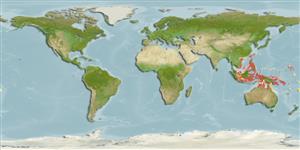Environment: milieu / climate zone / rango de profundidad / distribution range
Ecología
marino; agua dulce; salobre pelagic-neritic; anfidromo (Ref. 51243). Tropical; 27°N - 21°S
Western Pacific: Ryukyu Islands to New Caledonia.
Tamaño / Peso / Age
Madurez: Lm ? range ? - ? cm
Max length : 23.0 cm SL macho / no sexado; (Ref. 7050)
Espinas dorsales (total) : 11 - 12; Radios blandos dorsales (total) : 10 - 11; Espinas anales: 3; Radios blandos anales: 8 - 9.
Body shape (shape guide): fusiform / normal.
Adults inhabit salt and brackish waters of bays and estuaries, penetrating into fresh water (Ref. 1601). Juveniles are sometimes found in streams within 5-10 km of the sea (Ref. 2847). Eggs are guarded and fanned by the male parent (Ref. 205).
Life cycle and mating behavior
Madurez | Reproducción | Puesta | Huevos | Fecundidad | Larva
Eggs are guarded and fanned by the male parent (Ref. 205).
Masuda, H., K. Amaoka, C. Araga, T. Uyeno and T. Yoshino, 1984. The fishes of the Japanese Archipelago. Vol. 1. Tokai University Press, Tokyo, Japan. 437 p. (text). (Ref. 559)
IUCN Red List Status (Ref. 130435: Version 2025-1)
Threat to humans
Harmless
Human uses
Pesquerías: escaso valor comercial; Acuicultura: posible uso futuro
Herramientas
Special reports
Download XML
Fuentes de Internet
Estimates based on models
Preferred temperature (Referencia
123201): 26.6 - 29.2, mean 28.7 °C (based on 1282 cells).
Phylogenetic diversity index (Referencia
82804): PD
50 = 0.5312 [Uniqueness, from 0.5 = low to 2.0 = high].
Bayesian length-weight: a=0.01288 (0.00590 - 0.02812), b=3.04 (2.86 - 3.22), in cm total length, based on LWR estimates for this (Sub)family-body shape (Ref.
93245).
Nivel trófico (Referencia
69278): 3.0 ±0.37 se; based on food items.
Resiliencia (Referencia
120179): Alto, población duplicada en un tiempo mínimo inferior a 15 meses (Preliminary K or Fecundity.).
Fishing Vulnerability (Ref.
59153): Low vulnerability (18 of 100).
🛈
